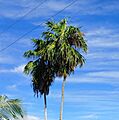Florida thatch palm facts for kids
Quick facts for kids Florida thatch palm |
|
|---|---|
 |
|
| Conservation status | |
| Scientific classification | |
| Genus: |
Thrinax
|
| Species: |
radiata
|
| Synonyms | |
|
Coccothrinax radiata |
|
The Thrinax radiata, also known as the Florida thatch palm, is a type of palm tree. It grows slowly to a medium size. This palm belongs to the Arecaceae family. You can find it naturally in many Caribbean islands, Mexico, Central America, and the very southern part of Florida. It likes to grow in sandy, chalky soil near the coast.
Contents
What the Florida Thatch Palm Looks Like
Like all palms, this plant first grows thick and low to the ground. Then, its main stem grows upwards, forming a tall, slender tree.
This palm does not have a crownshaft, which is a smooth part of the trunk found on some palms. Instead, its leaves seem to grow right from the trunk. On average, this palm can reach about 20 feet (6 meters) tall.
Its large leaves are 4 to 5 feet (1.2 to 1.5 meters) wide and 2.5 feet (0.76 meters) long. The leaves are shaped like a hand with fingers, and they split into segments about halfway down. The leaf connects to the stem in a pointed shape.
A full palm usually has between 10 and 20 large leaves. It grows taller by only about 6 inches (15 cm) each year. The shape of the leaves can change. Palms that get a lot of sun look more round or compact. Palms in the shade have longer, more spread-out leaves.
This palm can start to flower when it is only 6 feet (1.8 meters) tall. Its flower stalks are over 3 feet (0.9 meters) long and hang downwards, sometimes even below the leaves. The flowers are white and have both male and female parts. They bloom all year, but mostly in the spring. The fruits, called drupes, are white and can also be seen all year.
You can tell this palm apart from a similar type called Coccothrinax. The Florida thatch palm has white fruits, while Coccothrinax palms have black or yellow fruits. Also, the Florida thatch palm has split leaf bases, but Coccothrinax palms have fused leaf bases.
Other Names for This Palm
People call the Florida thatch palm by many different names. Some common names include Jamaican thatch, Jamaica thatch palm, chit, silk-top thatch palm, sea thatch palm, and Caribbean thatch palm.
Where the Palm Lives and What Animals Use It
The Florida thatch palm mostly grows in coastal scrub areas, from the Caribbean to Mexico. It can even grow in rocky limestone areas. Sometimes, you can also find it in pine forests in South Florida and in semi-evergreen forests in the Yucatán Peninsula.
Many animals eat its seeds, which helps spread them around. These animals include bats, spider monkeys, toucans, armadillos, and deer. Young leaves are also eaten by spider monkeys. Older leaves provide a safe place for several types of bats.
In Florida, especially on Elliott Key, a type of squirrel called the Mexican gray squirrel has caused problems for these palms. This squirrel uses the palm's fibers for its nests. It also eats parts of the palm, which can sometimes harm or even kill the plant.
Where You Can Find This Palm
In the wild, this palm almost always grows near coastal areas. It is very good at handling strong winds, lots of salt, and even dry weather. It naturally grows in sandy and chalky soils. It grows best in soil with a high pH.
This palm is native to southern Florida, the Florida Keys, and Puerto Rico in the United States. It also grows in western Cuba, the Bahamas, the Cayman Islands, Jamaica, Hispaniola (which includes the Dominican Republic and Haiti), the eastern coast of the Yucatán Peninsula in Mexico, Belize, Honduras, and Nicaragua.
How This Palm Is Classified
Scientists once thought the Florida thatch palm belonged to a related group called Coccothrinax. However, further study showed it is different. Plants are grouped by how they are related to each other, like a family tree. The Florida thatch palm is now in its own group, Thrinax.
Protecting the Florida Thatch Palm
Globally, this palm seems to be doing well. However, it is rare in Florida, which is the northern edge of its natural range. Even though people often plant it in gardens and along roads, it is not common in the wild in Florida.
Currently, there are no special efforts in the United States to help this palm. But in Mexico, there are rules about harvesting it. This is because people using the palm has had a bigger impact on its numbers there.
How People Use the Florida Thatch Palm
This palm is often planted in gardens and along roads in South Florida. It is popular because it can grow well in many different conditions. Gardeners use it, and it can be grown in pots or in special plant collections called arboretums. These places show off its many flowers and fruits.
The palm's common name, "thatch palm," comes from how its fronds (leaves) were used to make thatched roofs. Its fronds are the most used part of the palm. They are used to make brooms, handicrafts, and even to wrap food. The white fruits of the Thrinax radiata are edible. Recently, fishermen in the Yucatán Peninsula have started using its trunks to build lobster traps.
Gallery
See also
 In Spanish: Guano de costa para niños
In Spanish: Guano de costa para niños






